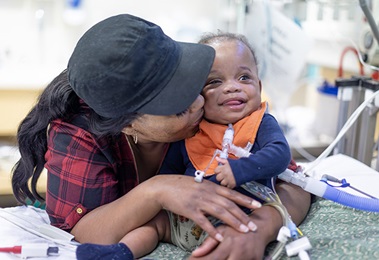Tracheomalacia
What is tracheomalacia?
Tracheomalacia in a newborn occurs when the cartilage in the windpipe, or trachea, has not developed properly. Instead of being rigid, the walls of the trachea are floppy, resulting in breathing difficulties soon after birth. Babies born with tracheomalacia may have other congenital abnormalities, such as heart defects, developmental delays and gastroesophageal reflux. Also, aspiration pneumonia can occur from inhaling food.
Symptoms
- Breathing noises that may change with position and improve during sleep
- Breathing problems that get worse with coughing, crying, feeding or upper respiratory infections
- High-pitched or rattling breathing
Diagnosis
A physical examination confirms the symptoms. A chest X-ray may show narrowing of the trachea when breathing in. A procedure called a laryngoscopy, which allows the otolaryngologist to see the airway structure, provides a definitive diagnosis. Other tests may include:
- Airway fluoroscopy
- Barium swallow
- Bronchoscopy (a camera down the throat to see the airways and lungs)
- CT scan
- Lung function tests
- MRI
Treatment
Most infants respond well to humidified air, careful feedings and antibiotics for infections. Babies with tracheomalacia must be closely monitored when they have respiratory infections. Often, the symptoms of tracheomalacia improve as the infant grows. Rarely, surgery is needed.
Prognosis
Congenital tracheomalacia generally goes away on its own between 18 and 24 months. As the tracheal cartilage gets stronger and the trachea grows, the noisy respirations and breathing difficulties gradually stop.






